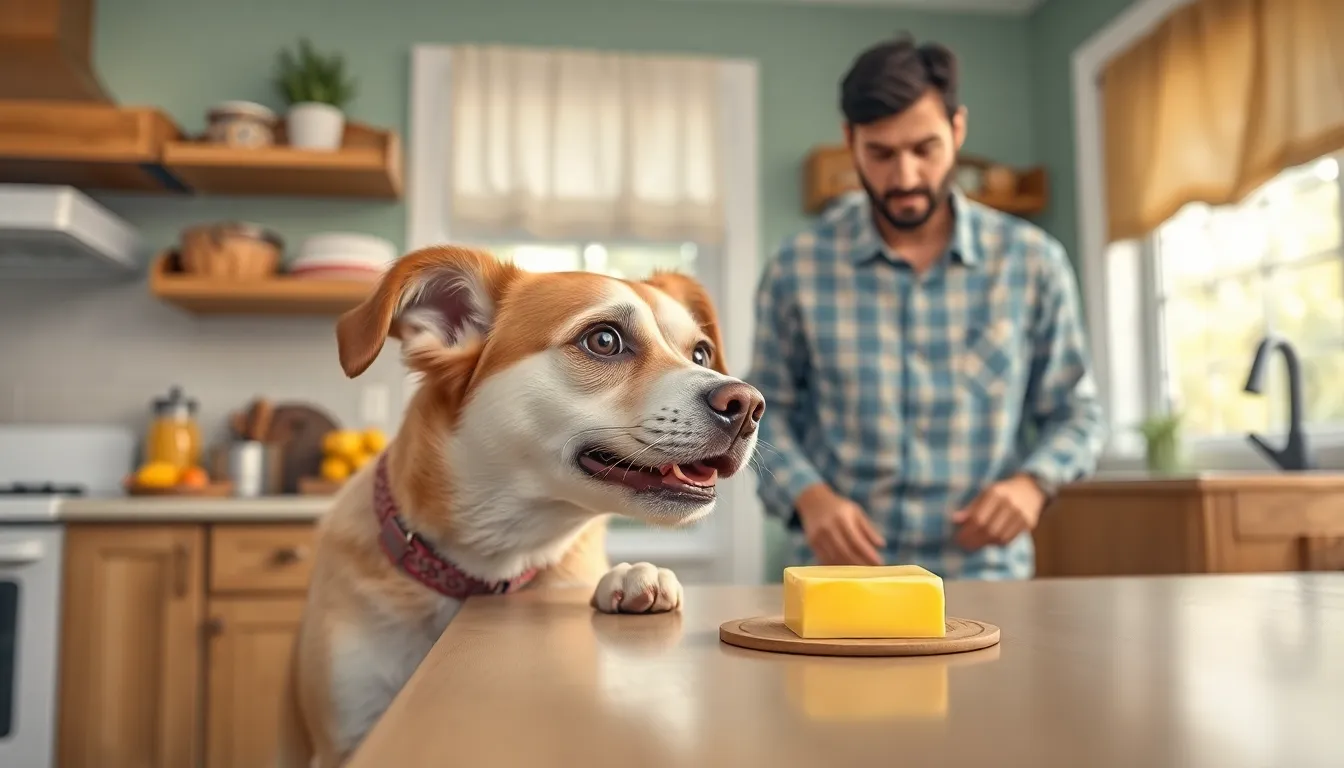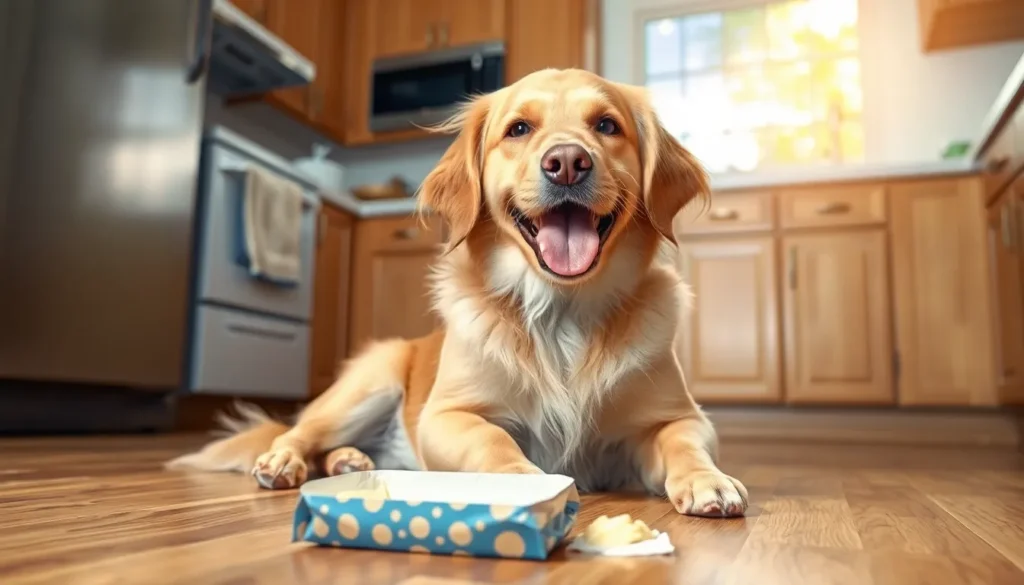Picture this: a sunny afternoon, the scent of freshly baked cookies wafting through the air, and your beloved dog, the ultimate food connoisseur, suddenly decides that a stick of butter is the gourmet treat of the day. It sounds outrageous, but this butter escapade isn’t just a one-off; it’s a hilarious reminder of why dogs can be both delightful and mischievous.
When a dog takes a culinary detour like this, it raises eyebrows and laughter. But behind the humor lies a serious question: what should you do next? From potential health implications to the inevitable guilt trip that follows, navigating the aftermath of a butter-loving pup can be quite the adventure. Buckle up as we dive into the comical chaos of canine cravings and what every dog owner should know when their furry friend indulges in something a bit too rich.
Table of Contents
ToggleThe Incident: My Dog Ate a Stick of Butter
A playful moment turned chaotic when the dog snatched a stick of butter from the kitchen counter. The buttery indulgence led to a flurry of unexpected reactions from the owner.
What Happened?
The dog, drawn by the alluring scent, jumped up and grabbed the stick of butter. One moment, it was happily lounging; the next, it was enjoying a greasy treat. The butter quickly disappeared as the pup devoured it in few seconds. Recognizing the empty wrapper left on the counter sparked immediate concern. Such a rich food could cause digestive issues, raising alarms about potential health risks. Observing the aftermath created a mix of humor and worry.
Initial Reactions
Shock hit the owner when realizing what occurred. Expressing disbelief, they exclaimed, “Did you really just eat that?” Instantly, panic crept in as thoughts of gastrointestinal distress surfaced. Searching online revealed that butter consumption might lead to pancreatitis in dogs. Phone calls to the vet provided guidance on monitoring for symptoms like vomiting or lethargy. Through shared laughter with friends about the mischievous act, relief gradually took over.
Understanding Dogs and Their Eating Behavior

Dogs often explore the world through their mouths, leading them to ingest a variety of unexpected items, including food and non-food objects. Such behavior frequently results in amusing yet concerning situations for owners.
Common Items Dogs Ingest
Dogs commonly consume household items like socks, trash, and chocolate. These items may seem innocuous to humans, but they can pose serious health risks to pets. Toys and plants also attract canine curiosity, sometimes leading to dangerous outcomes. Owners should monitor their dogs to minimize the chance of ingestion. Knowing which items fall into this category helps preemptively avoid issues.
The Appeal of Butter to Dogs
Butter often captures a dog’s attention due to its rich scent and creamy texture. Many dogs find the high-fat content irresistible, making it a desirable treat. The allure of butter can lead to rapid consumption, creating potential health hazards for dogs. Owners should recognize this tendency and maintain vigilance around food items. Understanding why dogs favor certain foods like butter aids in managing their diets effectively.
Potential Risks and Health Concerns
Understanding the risks associated with a dog consuming a stick of butter is crucial for pet owners. Dogs can experience various health issues after indulging in such rich foods.
Symptoms to Watch For
Vomiting may occur shortly after ingestion. Dogs often exhibit signs of discomfort, such as pacing or whining. Excessive drooling can signal an upset stomach. Diarrhea is another common reaction, indicating digestive distress. Behavioral changes, including lethargy or restlessness, may also appear. Quick observation of these symptoms helps in determining the severity of the situation.
Possible Gastric Issues
Consuming a stick of butter can trigger serious gastric issues in dogs. Pancreatitis stands out as a major concern, characterized by inflammation of the pancreas. This condition may lead to severe pain and requires immediate veterinary intervention. Bloating can occur as well, causing a swollen abdomen and potential risk of gastric torsion. The high-fat content might also cause gastrointestinal upset, resulting in diarrhea or constipation. Assessing dietary habits and monitoring reactions after such incidents helps safeguard a dog’s health.
What to Do If Your Dog Eats Butter
Eating butter, especially in large amounts, can lead to health issues for dogs. Acting promptly can make a difference in your pet’s well-being.
Immediate Actions to Take
First, assess how much butter your dog consumed. Small amounts might not cause significant harm, but larger quantities pose risks. Observe your dog’s behavior closely for signs of distress. Watch for vomiting, excessive drooling, or lethargy. Ensure you remove any remaining butter to prevent further consumption. Offer water to help with possible digestion issues. Keeping a calm demeanor can also ease your dog’s anxiety during this time.
When to Consult a Veterinarian
Consulting a veterinarian is crucial in certain situations. If your dog shows any worrisome symptoms like bloating or continuous vomiting, seek help immediately. Similarly, consider contacting the vet if your pet consumes an entire stick of butter. A veterinarian can provide tailored advice based on your dog’s size and health history. It is always better to err on the side of caution, especially when it comes to rich foods. Timely intervention can prevent complications like pancreatitis, ensuring your dog stays healthy and safe.
Preventative Measures
Implementing preventative measures can reduce the likelihood of dogs consuming inappropriate items. Pet owners can take various steps to create a safer environment for their furry friends.
Dog-Proofing Your Kitchen
Securing food items is crucial. Keep counters clear and store all food, especially rich items like butter, in cabinets or containers. Use childproof locks on lower cabinets to prevent curious pups from exploring. Ensuring trash cans have secure lids also helps keep enticing snacks out of reach. Regularly check for any spills or crumbs on the floor that could attract a hungry dog. Dogs are expert foragers, so vigilance in the kitchen is necessary.
Safe Treat Alternatives
Offering safe, healthy treats can satisfy dogs’ cravings without the risks associated with rich foods. Choose options like carrot sticks, apple slices, or commercially made dog treats that are low in fat. These alternatives provide a tasty experience without gastrointestinal distress. Incorporating dental chews helps maintain oral health while providing enjoyment. Always check ingredient lists to avoid treats with harmful additives. It’s essential to transition slowly any new treats to avoid digestive upset and prolong happy moments.
Experiencing a dog’s unexpected culinary adventure can be both amusing and concerning. While the joy of watching a pet indulge in something as simple as a stick of butter can bring laughter it’s crucial to remain vigilant about their health. Understanding the potential risks associated with such indulgences can help pet owners respond appropriately.
By fostering a safe environment and offering healthier alternatives, pet owners can prevent similar situations from arising in the future. Keeping a close eye on a dog’s eating habits and behaviors ensures that moments of mischief don’t lead to serious health issues. With a little preparation and awareness, owners can enjoy the playful side of their pets while keeping them safe and healthy.









